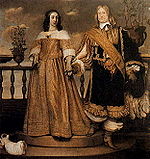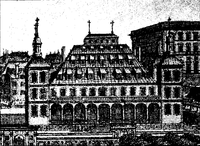
Countess Palatine Maria Eufrosyne of Zweibrücken
Encyclopedia


Christina of Sweden
Christina , later adopted the name Christina Alexandra, was Queen regnant of Swedes, Goths and Vandals, Grand Princess of Finland, and Duchess of Ingria, Estonia, Livonia and Karelia, from 1633 to 1654. She was the only surviving legitimate child of King Gustav II Adolph and his wife Maria Eleonora...
and sister of king Charles X of Sweden. She was also, after the accession of her brother Charles X on the throne (1654), a titular Royal Princess of Sweden.
Biography
Maria Eufrosyne was born to Count PalatineCount palatine
Count palatine is a high noble title, used to render several comital styles, in some cases also shortened to Palatine, which can have other meanings as well.-Comes palatinus:...
John Casimir of Zweibrücken
John Casimir, Count Palatine of Kleeburg
John Casimir, Count Palatine of Zweibrücken-Kleeburg was the son of John I, Count Palatine of Zweibrücken and the founder of a branch of Wittelsbach Counts Palatine often called the Swedish line, because it gave rise to three subsequent kings of Sweden, but more commonly known as the Kleeburg ...
and Princess Catherine of Sweden. Her family fled from Germany during the Thirty Years War (1622), and Maria and her siblings grew up in her mother's country; Maria herself was born in Sweden. She was initially brought up with Christina as her foster-sister, but soon, Christina was tutored separately, as she was given the same education as a man was given due to her position as a monarch.
Maria Eufrosyne was married to Christina's favourite Count Magnus Gabriel De la Gardie
Magnus Gabriel De la Gardie
Count Magnus Gabriel De la Gardie was a Swedish statesman and military man. He became a member of the Swedish Privy Council in 1647 and came to be the holder of three of the five offices counted as the Great Officers of the Realm, namely Lord High Treasurer, Lord High Chancellor and Lord High...
, on 7 March 1645 at the royal chapell at Tre Kronor (castle)
Tre kronor (castle)
Tre Kronor or Three Crowns was a castle located in Stockholm, Sweden, on the site where Stockholm Palace is today. It is believed to have been a citadel that Birger Jarl built into a royal castle in the middle of the 13th century...
, in a marriage believed to have been arranged by Queen Christina. Tradition has regarded this as a triangle drama; Christina and Maria Eufrosyne were both believed to have been in love with Magnus, and in the end, Christina gave up the plans of marrying him herself, and gave him to her cousin with the words: I give to you what I can not have myself. A famous play has been written about this drama. It is not known how much of this legendary triangle drama is true, however. The marriage is not described as happy. The couple was forced to leave the court in 1653 after a disagreement with the queen, but could return the year after, when the brother of Maria Eufrosyne ascended to the throne.
At the coronation of her brother Charles X in 1654, Maria Eufrosyne was granted the rank and status of a Royal Princess of Sweden, although this was opposed by some parts of the nobility
Nobility
Nobility is a social class which possesses more acknowledged privileges or eminence than members of most other classes in a society, membership therein typically being hereditary. The privileges associated with nobility may constitute substantial advantages over or relative to non-nobles, or may be...
. Maria Eufrosyne did not use the title of Countess, but was generally referred to as "The Princess". She often received petitions on behalf of those who wanted her to speak to her husband on their account, and in the same fashion, she acted as mediator for her husband in the royal family, especially when he was out of favour with the monarch. In 1676, a witness in a witch trial
Witch-hunt
A witch-hunt is a search for witches or evidence of witchcraft, often involving moral panic, mass hysteria and lynching, but in historical instances also legally sanctioned and involving official witchcraft trials...
inspired by the famous Gävle-Boy
Gävle-Boy
The so called Gävle Boy, which was the nickname for Johan Johansson Griis, , was a young Swedish boy remembered for being a witness in witch trials and for bearing the large responsibility for the witch trial of Stockholm in 1676....
, Lisbeth Carlsdotter, tried to implicate her and her sister-in-law Maria Sofia
Maria Sofia De la Gardie
Maria Sofia De la Gardie, as married Oxenstierna of Croneborg , was a Swedish noble and entrepreneur. She has been called the first female grand entrepreneur of her country.-Biography:...
in the trial, which was not taken seriously and fell back upon Carlsdotter, and instead lead to the trial being dissolved. A lot of the family's property was confiscated
Confiscation
Confiscation, from the Latin confiscatio 'joining to the fiscus, i.e. transfer to the treasury' is a legal seizure without compensation by a government or other public authority...
by the crown in 1682 during the 1680s reduction by King Charles XI. She became a widow in 1686, and died one year later.
Family
Married to Magnus Gabriel De la Gardie 7 March 1645. Out of eleven children, only three became adults, and only one (Hedvig Ebba), had issue; her grandson, however, died childless.Issue
- Gustaf Adolf De la Gardie (1647–1695), unmarried, no issue.
- Catharina Charlotta De la Gardie (1655-1697), married to Otto Wilhelm KönigsmarckOtto Wilhelm KönigsmarckCount Otto Wilhelm Königsmarck was a Swedish military officer from Minden. He attained the rank of field marshal in 1676, commanded the Battle of Stralsund , and became Governor General for Swedish Pomerania in 1679. He was the son of Hans Christoff Königsmarck and the brother of Conrad Christoff...
, no issue. - Hedvig Ebba De la Gardie (1657 - ), married to Carl Gustaf Oxenstierna (Eriksson), one son, who died childless.

